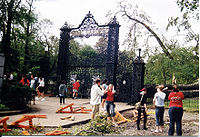
Halifax Public Gardens
Encyclopedia

Victorian era
The Victorian era of British history was the period of Queen Victoria's reign from 20 June 1837 until her death on 22 January 1901. It was a long period of peace, prosperity, refined sensibilities and national self-confidence...
public gardens formally established in 1867, the year of Canadian Confederation
Canadian Confederation
Canadian Confederation was the process by which the federal Dominion of Canada was formed on July 1, 1867. On that day, three British colonies were formed into four Canadian provinces...
. The gardens are located in the Halifax Regional Municipality, Nova Scotia
Nova Scotia
Nova Scotia is one of Canada's three Maritime provinces and is the most populous province in Atlantic Canada. The name of the province is Latin for "New Scotland," but "Nova Scotia" is the recognized, English-language name of the province. The provincial capital is Halifax. Nova Scotia is the...
on the Halifax Peninsula
Halifax Peninsula
The Halifax Peninsula is a community and planning area located in the urban core of Halifax Regional Municipality in the province of Nova Scotia. Halifax Peninsula is home to Downtown Halifax, the financial and economic heart of the region, which was also the site of the original settlement and...
near the popular shopping district of Spring Garden Road
Spring Garden, Halifax
Spring Garden, along with Barrington Street and Quinpool Road, is a major commercial and cultural district in Halifax, Nova Scotia, Canada. It comprises Spring Garden Road, South Park Street, and a number of smaller side streets...
. The gardens were designated as a national historic site in 1984.
The Public Gardens encompass 16 acres and are bounded by Spring Garden Road, South Park Street, Summer Street and Sackville Street. They are open annually from approximately May 1 until November 1. The landscaping style is Victorian formal and provides a popular setting for wedding and prom photos. In addition to statues and extensive flower beds, there are three fountains, two stone bridges, three ponds (one large and two small), and a small concession building (located in the original Horticultural Hall). The gardens also feature a bandstand
Bandstand
A bandstand is a circular or semicircular structure set in a park, garden, pier, or indoor space, designed to accommodate musical bands performing concerts...
that is used for free public concerts on Sunday afternoons during the summer. There are celebrations in the gardens every year on Canada day (July 1st) and Natal Day (the first Monday in August).
In the past, many people enjoyed feeding the ducks who make the gardens their home, although it is now prohibited.
The Public Gardens were badly damaged by Hurricane Juan
Hurricane Juan
Hurricane Juan was a significant hurricane that struck the southern part of Atlantic Canada in late September 2003. It was the tenth named storm and the sixth hurricane of the 2003 Atlantic hurricane season. Juan formed southeast of Bermuda on September 24, 2003 out of a tropical wave that tracked...
in 2003. Many trees were destroyed, necessitating the early closure of the gardens and some redesign. The gardens reopened on Canada Day
Canada Day
Canada Day , formerly Dominion Day , is the national day of Canada, a federal statutory holiday celebrating the anniversary of the July 1, 1867, enactment of the British North America Act , which united three British colonies into a single country, called Canada, within the British Empire...
, 2004 after a restoration aided in part by $1 million which was raised during a radio telethon.
The Public Gardens has various war monuments: a commemorative plaque for the Halifax Provisional Battalion
Halifax Provisional Battalion
The Halifax Provisional Battalion was a military unit from Nova Scotia, Canada, which was sent to fight in the North-West Rebellion in 1885. The battalion was under command of Lieutenant-Colonel James J...
(1785) which served in the North West Rebellion; a statue of a soldier from the Second Boer War
Second Boer War
The Second Boer War was fought from 11 October 1899 until 31 May 1902 between the British Empire and the Afrikaans-speaking Dutch settlers of two independent Boer republics, the South African Republic and the Orange Free State...
; and a tree planted in memory of the first Canadian casualty of the Boer War, Charles Carroll Wood
Charles Carroll Wood
Lieutenant Charles Carroll Wood was a Canadian soldier, who became famous because he was the first Canadian to die in the Second Boer War. He is the namesake of the Chaswood, Nova Scotia....
.
Further reading
- The Halifax Public Gardens, The Friends of the Public Gardens, Halifax, 1989
- "The Magnolia Tree", a short story by Barbara GrantmyreBarbara GrantmyreBarbara Grantmyre was a Canadian writer. Born Barbara Lucas, she is known for several works of nonfiction including Lunar Rogue about the criminal Henry More Smith and The River that Missed the Boat about the Shubenacadie Canal. She also wrote short stories including a collection published as A...
published in Atlantic Anthology, Will R. Bird, ed., McLelland & Stewart, 1959.

